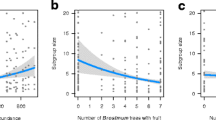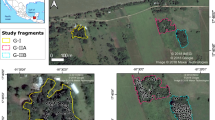Abstract
We examined the effects of fruit patch size, density, and distribution on feeding subgroup size and feeding bout duration in four Neotropical primates—Lagothrix lagotricha, Ateles belzebuth, Cebus apella, and Alouatta seniculus—based on 2494 hr of focal animal sampling in Tinigua National Park, Colombia. All four species show positive correlations between patch size (tree diameter at breast height; DBH) and subgroup size (maximum number of individuals from the focal group feeding at the same time), but the determination coefficients are very low and this relationship does not seem to influence strongly the actual size of the groups. Ateles showed the weakest correlation between patch size and feeding party size, and their fission–fusion sociality is best explained as a mechanism to reduce intragroup competition rather than to adjust the subgroup size to the availability of patches. Feeding associations as well as proximal spacing patterns, in general, are more alike in species with similar ecological requirements.
Similar content being viewed by others
REFERENCES
Chapman, C. (1990). Ecological constraints on group size in three species of neotropical primates. Folia Primatol. 55: 1-9.
Crook, J. H., and Gartlan, J. S. (1966). Evolution of primate societies. Nature 210: 1200-1203.
Eisenberg, J. F., Muckenhirn, N. A., and Rudran, R. (1972). The relation between ecology and social structure in primates. Science 176: 863-874.
Freeland, W. J. (1976). Pathogens and the evolution of primate sociality. Biotropica 8: 12-24.
Janson, C. H. (1992). Evolutionary ecology of primate social structure. In Smith, E. A., and Winterhalder, B. (eds.), Evolutionary Ecology and Human Behavior, De Gruyter, New York, pp. 95-130.
Klein, L. L., and Klein, D. J. (1977). Feeding behavior of the Columbian spider monkey. In Clutton-Brock, T. (ed.), Primate Ecology, Academic Press, New York, pp. 153-182.
Leighton, M., and Leighton, D. R. (1982). The relationship of size of feeding aggregate to size of food patch: Howler monkeys (Alouatta palliata) feeding in Trichilia cipo fruit trees on Barro Colorado Island. Biotropica 14(2): 81-90.
Milton, K. (1984). Habitat, diet, and activity patterns of free-ranging woolly spider monkeys (Brachyteles arachnoides E. Geoffroy 1806). Int. J. Primatol. 5: 491-514.
Sokal, P. R., and Rohlf, F. J. (1995). Biometry, 3rd ed., W. H. Freeman, New York.
Stevenson, P. R., Quiñones, M. J., and Ahumada, J. A. (1994). Ecological strategies of woolly monkeys (Lagothrix lagotricha) at Tinigua National Park, Colombia. Am. J. Primatol. 32: 123-140.
Strier, K. (1989). Effects of patch size on feeding associations in Muriquis (Brachyteles arachnoides). Folia Primatol. 52: 70-77.
Symington, M. M. (1988). Food competition and foraging subgroup size in the black spider monkey (Ateles paniscus chamek). Behaviour 105: 117-134.
Terborgh, J. (1983). Five New World Primates: A Story in Comparative Ecology, Princeton University Press, Princeton, NJ.
Terborgh, J., and Janson, C. H. (1986). The socioecology of primate groups. Annu. Rev. Ecol. Syst. 17: 111-135.
Wrangham, R. W. (1977). Feeding behaviour of chimpanzees in Gombe National Park, Tanzania. In Clutton-Brock, T. (ed.), Primate Ecology, Academic Press, New York, pp. 503-538.
Wrangham, R. W. (1978). Evolution of social structure. In Smuts, B. B., Cheney, D. L., Seyfarth, R. M., Wrangham, R. W., and Struhsaker, T. T. (eds.), Primate Societies, University of Chicago Press, Chicago, pp. 282-296.
Author information
Authors and Affiliations
Rights and permissions
About this article
Cite this article
Stevenson, P.R., Quiñones, M.J. & Ahumada, J.A. Effects of Fruit Patch Availability on Feeding Subgroup Size and Spacing Patterns in Four Primate Species at Tinigua National Park, Colombia. International Journal of Primatology 19, 313–324 (1998). https://doi.org/10.1023/A:1020387700923
Issue Date:
DOI: https://doi.org/10.1023/A:1020387700923




